Thesis: Zaha Hadid's Unique Architecture and Technological Advancement
VerifiedAdded on 2023/06/15
|5
|874
|458
Essay
AI Summary
This essay analyzes Zaha Hadid's unique architectural designs and their relationship with technological advancements. It investigates the uniqueness of Hadid's designs and how they correspond with technology, addressing the problem that architectural designs must meet both client needs and technological advancements. The research questions focus on the uniqueness of Hadid's designs and their match with technological advancement. The methodology involves a literature review of Hadid's designs and their impact on architecture, analyzing their technological requirements and challenges. The essay references several works by and about Zaha Hadid to support its analysis.
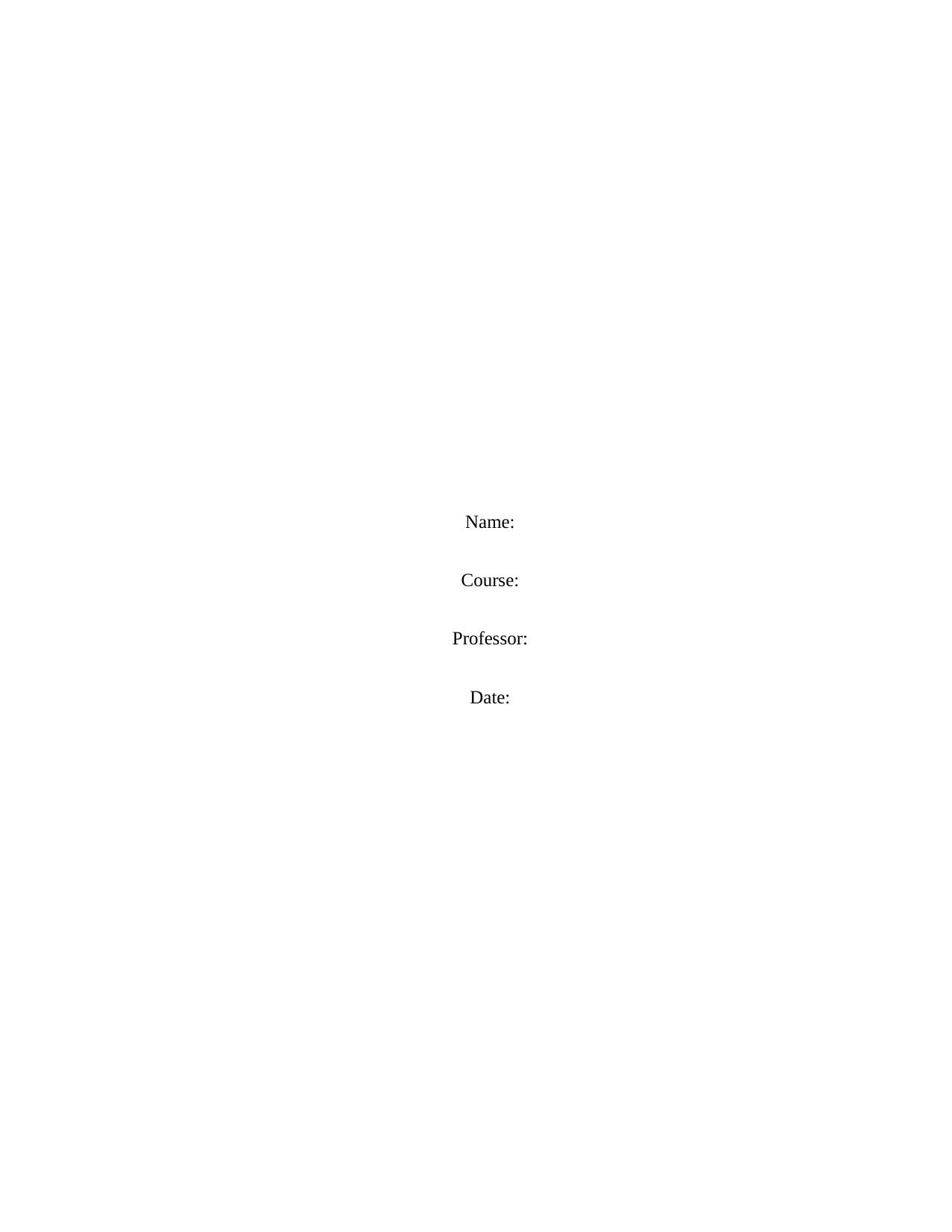
Name:
Course:
Professor:
Date:
Course:
Professor:
Date:
Paraphrase This Document
Need a fresh take? Get an instant paraphrase of this document with our AI Paraphraser
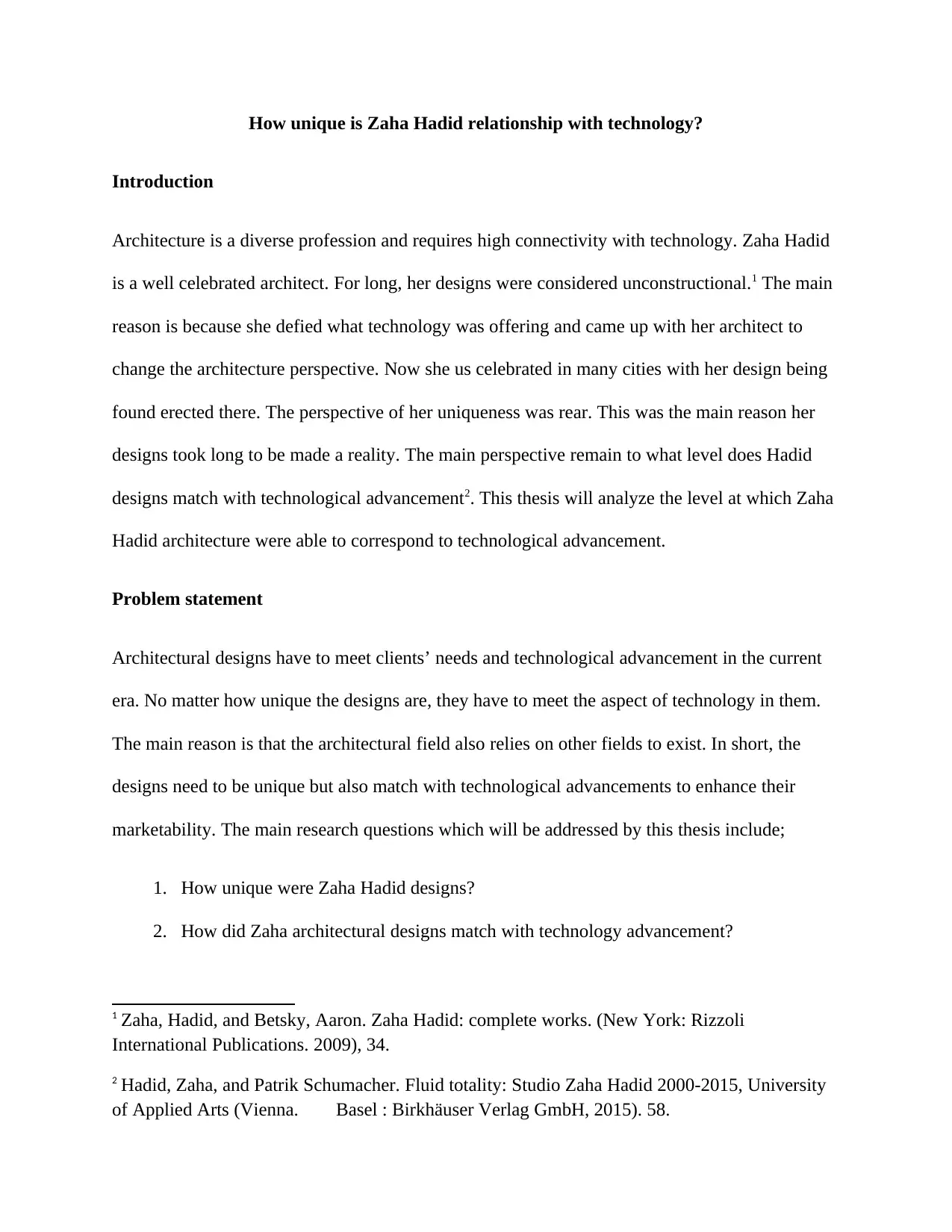
How unique is Zaha Hadid relationship with technology?
Introduction
Architecture is a diverse profession and requires high connectivity with technology. Zaha Hadid
is a well celebrated architect. For long, her designs were considered unconstructional.1 The main
reason is because she defied what technology was offering and came up with her architect to
change the architecture perspective. Now she us celebrated in many cities with her design being
found erected there. The perspective of her uniqueness was rear. This was the main reason her
designs took long to be made a reality. The main perspective remain to what level does Hadid
designs match with technological advancement2. This thesis will analyze the level at which Zaha
Hadid architecture were able to correspond to technological advancement.
Problem statement
Architectural designs have to meet clients’ needs and technological advancement in the current
era. No matter how unique the designs are, they have to meet the aspect of technology in them.
The main reason is that the architectural field also relies on other fields to exist. In short, the
designs need to be unique but also match with technological advancements to enhance their
marketability. The main research questions which will be addressed by this thesis include;
1. How unique were Zaha Hadid designs?
2. How did Zaha architectural designs match with technology advancement?
1 Zaha, Hadid, and Betsky, Aaron. Zaha Hadid: complete works. (New York: Rizzoli
International Publications. 2009), 34.
2 Hadid, Zaha, and Patrik Schumacher. Fluid totality: Studio Zaha Hadid 2000-2015, University
of Applied Arts (Vienna. Basel : Birkhäuser Verlag GmbH, 2015). 58.
Introduction
Architecture is a diverse profession and requires high connectivity with technology. Zaha Hadid
is a well celebrated architect. For long, her designs were considered unconstructional.1 The main
reason is because she defied what technology was offering and came up with her architect to
change the architecture perspective. Now she us celebrated in many cities with her design being
found erected there. The perspective of her uniqueness was rear. This was the main reason her
designs took long to be made a reality. The main perspective remain to what level does Hadid
designs match with technological advancement2. This thesis will analyze the level at which Zaha
Hadid architecture were able to correspond to technological advancement.
Problem statement
Architectural designs have to meet clients’ needs and technological advancement in the current
era. No matter how unique the designs are, they have to meet the aspect of technology in them.
The main reason is that the architectural field also relies on other fields to exist. In short, the
designs need to be unique but also match with technological advancements to enhance their
marketability. The main research questions which will be addressed by this thesis include;
1. How unique were Zaha Hadid designs?
2. How did Zaha architectural designs match with technology advancement?
1 Zaha, Hadid, and Betsky, Aaron. Zaha Hadid: complete works. (New York: Rizzoli
International Publications. 2009), 34.
2 Hadid, Zaha, and Patrik Schumacher. Fluid totality: Studio Zaha Hadid 2000-2015, University
of Applied Arts (Vienna. Basel : Birkhäuser Verlag GmbH, 2015). 58.
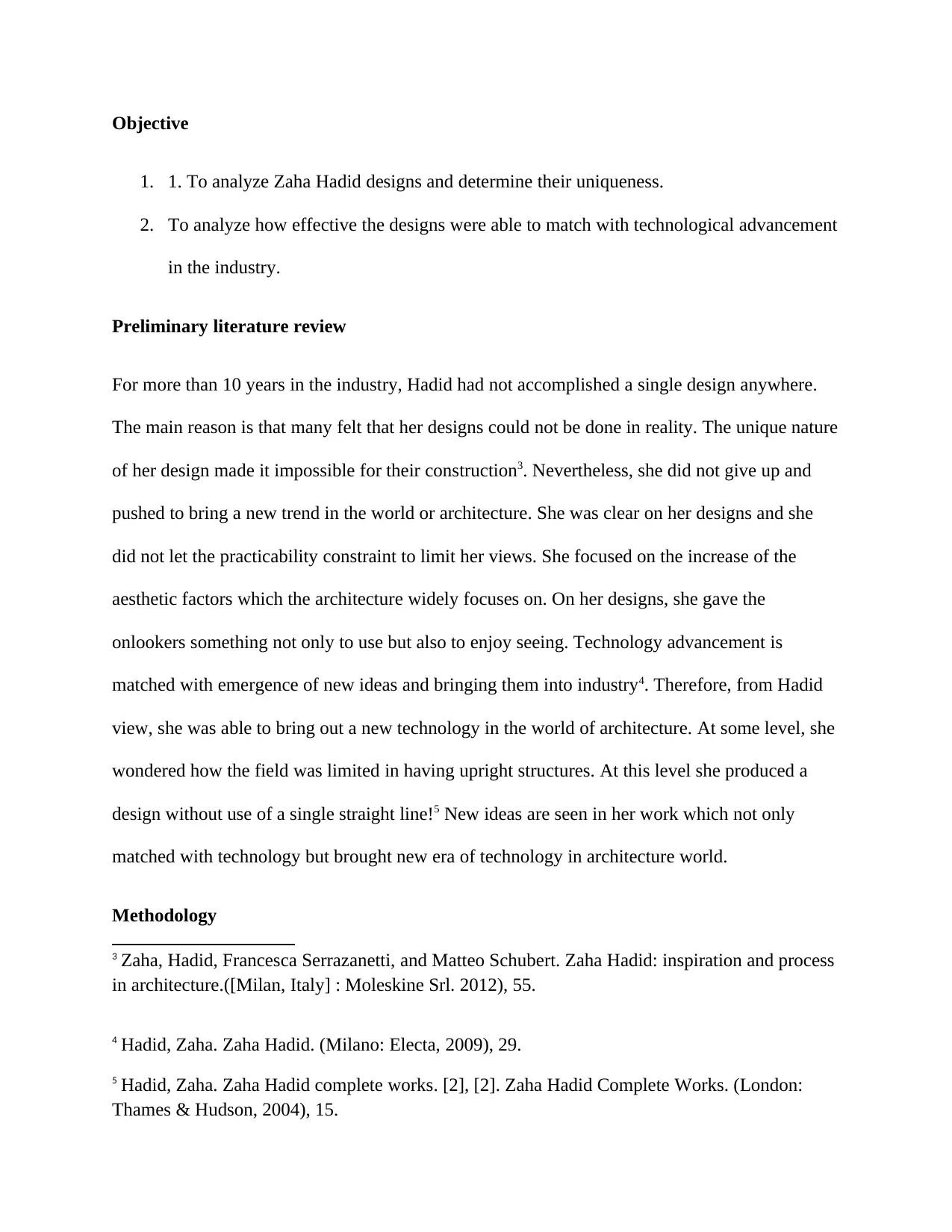
Objective
1. 1. To analyze Zaha Hadid designs and determine their uniqueness.
2. To analyze how effective the designs were able to match with technological advancement
in the industry.
Preliminary literature review
For more than 10 years in the industry, Hadid had not accomplished a single design anywhere.
The main reason is that many felt that her designs could not be done in reality. The unique nature
of her design made it impossible for their construction3. Nevertheless, she did not give up and
pushed to bring a new trend in the world or architecture. She was clear on her designs and she
did not let the practicability constraint to limit her views. She focused on the increase of the
aesthetic factors which the architecture widely focuses on. On her designs, she gave the
onlookers something not only to use but also to enjoy seeing. Technology advancement is
matched with emergence of new ideas and bringing them into industry4. Therefore, from Hadid
view, she was able to bring out a new technology in the world of architecture. At some level, she
wondered how the field was limited in having upright structures. At this level she produced a
design without use of a single straight line!5 New ideas are seen in her work which not only
matched with technology but brought new era of technology in architecture world.
Methodology
3 Zaha, Hadid, Francesca Serrazanetti, and Matteo Schubert. Zaha Hadid: inspiration and process
in architecture.([Milan, Italy] : Moleskine Srl. 2012), 55.
4 Hadid, Zaha. Zaha Hadid. (Milano: Electa, 2009), 29.
5 Hadid, Zaha. Zaha Hadid complete works. [2], [2]. Zaha Hadid Complete Works. (London:
Thames & Hudson, 2004), 15.
1. 1. To analyze Zaha Hadid designs and determine their uniqueness.
2. To analyze how effective the designs were able to match with technological advancement
in the industry.
Preliminary literature review
For more than 10 years in the industry, Hadid had not accomplished a single design anywhere.
The main reason is that many felt that her designs could not be done in reality. The unique nature
of her design made it impossible for their construction3. Nevertheless, she did not give up and
pushed to bring a new trend in the world or architecture. She was clear on her designs and she
did not let the practicability constraint to limit her views. She focused on the increase of the
aesthetic factors which the architecture widely focuses on. On her designs, she gave the
onlookers something not only to use but also to enjoy seeing. Technology advancement is
matched with emergence of new ideas and bringing them into industry4. Therefore, from Hadid
view, she was able to bring out a new technology in the world of architecture. At some level, she
wondered how the field was limited in having upright structures. At this level she produced a
design without use of a single straight line!5 New ideas are seen in her work which not only
matched with technology but brought new era of technology in architecture world.
Methodology
3 Zaha, Hadid, Francesca Serrazanetti, and Matteo Schubert. Zaha Hadid: inspiration and process
in architecture.([Milan, Italy] : Moleskine Srl. 2012), 55.
4 Hadid, Zaha. Zaha Hadid. (Milano: Electa, 2009), 29.
5 Hadid, Zaha. Zaha Hadid complete works. [2], [2]. Zaha Hadid Complete Works. (London:
Thames & Hudson, 2004), 15.
⊘ This is a preview!⊘
Do you want full access?
Subscribe today to unlock all pages.

Trusted by 1+ million students worldwide
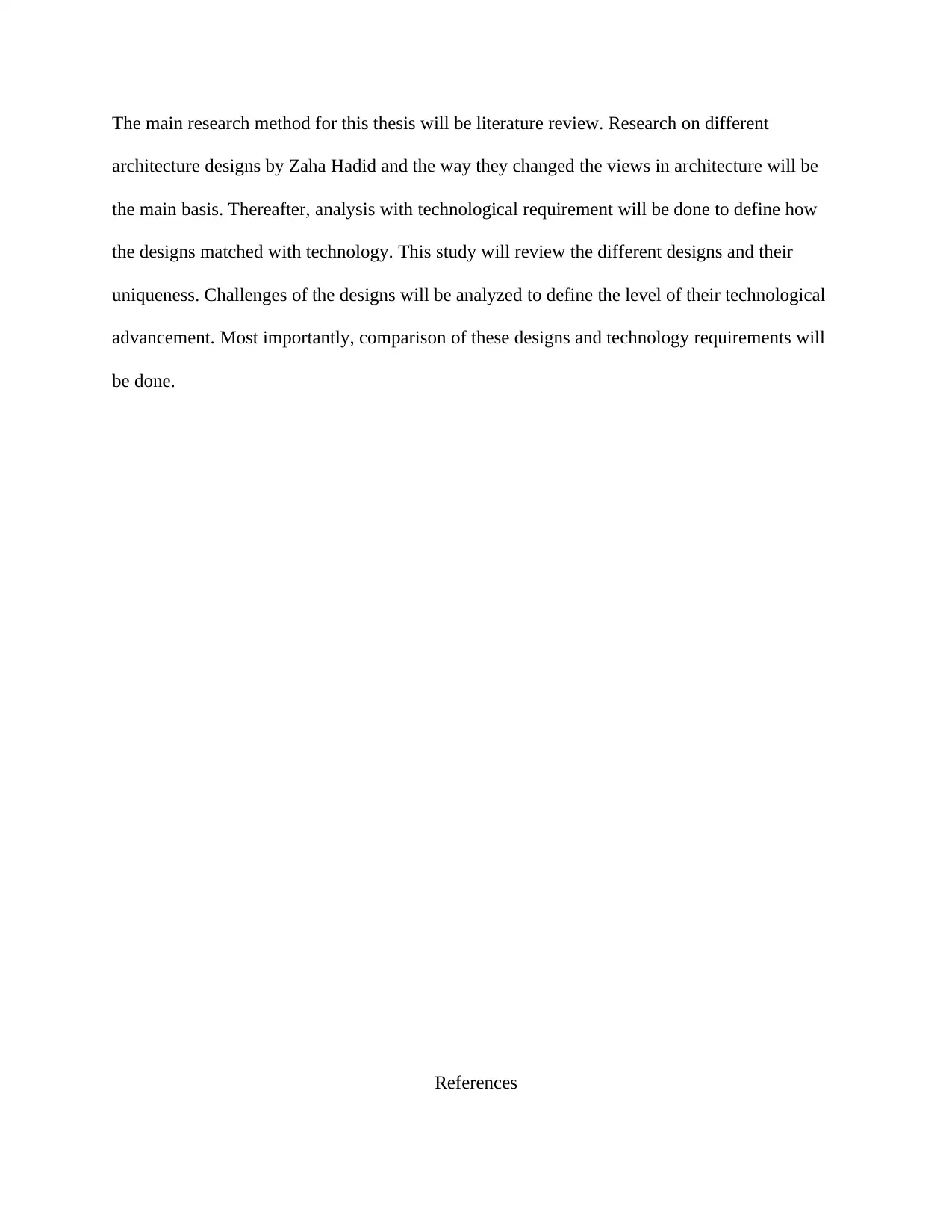
The main research method for this thesis will be literature review. Research on different
architecture designs by Zaha Hadid and the way they changed the views in architecture will be
the main basis. Thereafter, analysis with technological requirement will be done to define how
the designs matched with technology. This study will review the different designs and their
uniqueness. Challenges of the designs will be analyzed to define the level of their technological
advancement. Most importantly, comparison of these designs and technology requirements will
be done.
References
architecture designs by Zaha Hadid and the way they changed the views in architecture will be
the main basis. Thereafter, analysis with technological requirement will be done to define how
the designs matched with technology. This study will review the different designs and their
uniqueness. Challenges of the designs will be analyzed to define the level of their technological
advancement. Most importantly, comparison of these designs and technology requirements will
be done.
References
Paraphrase This Document
Need a fresh take? Get an instant paraphrase of this document with our AI Paraphraser
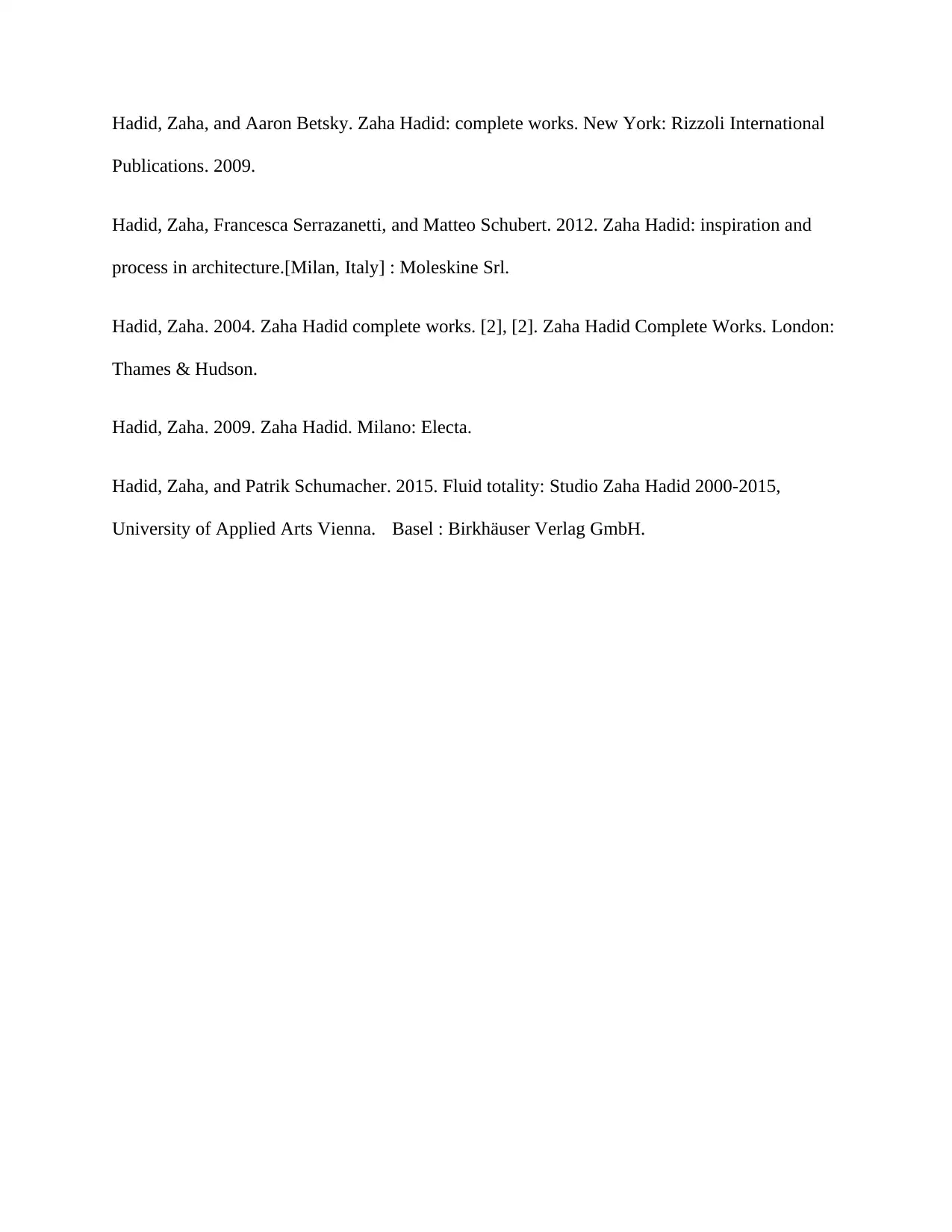
Hadid, Zaha, and Aaron Betsky. Zaha Hadid: complete works. New York: Rizzoli International
Publications. 2009.
Hadid, Zaha, Francesca Serrazanetti, and Matteo Schubert. 2012. Zaha Hadid: inspiration and
process in architecture.[Milan, Italy] : Moleskine Srl.
Hadid, Zaha. 2004. Zaha Hadid complete works. [2], [2]. Zaha Hadid Complete Works. London:
Thames & Hudson.
Hadid, Zaha. 2009. Zaha Hadid. Milano: Electa.
Hadid, Zaha, and Patrik Schumacher. 2015. Fluid totality: Studio Zaha Hadid 2000-2015,
University of Applied Arts Vienna. Basel : Birkhäuser Verlag GmbH.
Publications. 2009.
Hadid, Zaha, Francesca Serrazanetti, and Matteo Schubert. 2012. Zaha Hadid: inspiration and
process in architecture.[Milan, Italy] : Moleskine Srl.
Hadid, Zaha. 2004. Zaha Hadid complete works. [2], [2]. Zaha Hadid Complete Works. London:
Thames & Hudson.
Hadid, Zaha. 2009. Zaha Hadid. Milano: Electa.
Hadid, Zaha, and Patrik Schumacher. 2015. Fluid totality: Studio Zaha Hadid 2000-2015,
University of Applied Arts Vienna. Basel : Birkhäuser Verlag GmbH.
1 out of 5
Your All-in-One AI-Powered Toolkit for Academic Success.
+13062052269
info@desklib.com
Available 24*7 on WhatsApp / Email
![[object Object]](/_next/static/media/star-bottom.7253800d.svg)
Unlock your academic potential
Copyright © 2020–2025 A2Z Services. All Rights Reserved. Developed and managed by ZUCOL.

